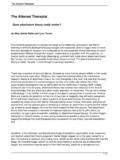Transcription of Barrumbi Kids teachers[1] - Leonie Norrington.com
1 The Barrumbi kids by Leonie Norrington Teachers notes The Barrumbi kids brilliantly captures the paradoxes of life in the rural north of Australia, showing with honesty and humour the complexities of cross-cultural living. Leonie Norrington says that she was motivated to write for children because she wanted her grandson "to know that Aboriginal and white people can live together despite their different cultures." The following notes are designed to assist the classroom teacher in communicating and exploring some of the rich themes and ideas contained in the novel. It is by no means implied that you should work through all of the exercises, notes and discussions found here, but that you select and use those suited to make-up and level of your class. Pre-reading Activities: 1. Look at a local Indigenous Community and discuss: What skin groups live there?
2 What language(s) are spoken? How abundant is the local bush tucker and what foods are available? How does the community interact with the nearest urban centre? Try to source a local person who has spent time on the community, and have them share their knowledge with the class. 2. Familiarise your class with the meaning of Dreaming and Dream-time stories, and the link between these and the Aboriginal art your students see around your locality. You may find you have some experts in your class, especially among your Indigenous students. If so, encourage them to teach the class about their own experiences and to share the stories they know. 3. There are also some good resources on the Internet. Try the following sites: (This is an Australian Museum Website. You will require an up-to date version of Real Player to hear stories, but the site also features accurate and comprehensive written information) (This site focuses on South Australian stories).
3 The Barrumbi kids by Leonie Norrington (Contains lesson plans for teaching dreamtime stories, based on the thinking hats model.) Beginning to Read The cover of the novel features elements of Aboriginal art, but these are combined with other styles. Ask students to predict what the novel may be about: ask them to judge the book by its cover! Look at the map of the Long Hole community: how is it similar and different to the town or city students live in? Chapter 1: Wagging The author immediately creates atmosphere in this chapter: the vivid description of the dry season breeze, personified as it enters the classroom to tickle [Dale s] hair , and the aromatic depiction of the yeasty scent of dry spear grass which distracts Dale from his studies. The character of Gordon Armstrong is introduced here (p.)
4 2) and we immediately understand what type of person he is a bully who ingratiates himself with his teacher at the same time as getting others into trouble. Dale has a particular reason for disliking Gordon: his father has just taken the position of station manager above Dale s father, who was previously in charge. Neither Dale s family or the Armstrongs are Indigenous. Discuss: How Dale might be feeling about these new residents Why Gordon might be acting as he does Chapter 2: Burn off Time The third person omniscient narrator moves here to Tomias s point of view, and we find out why he is not quick to wag with Dale: he s afraid of the consequences. Norrington uses Tomias s musings to explore Dale s family structure, and further develop Dale s character while he reveals his own. Miss Wilson expresses her reservations about the deliberately started bushfires, highlighting the differences in cultural points of view.
5 Write: The Barrumbi kids by Leonie Norrington Do you agree with Miss Wilson s point of view concerning bushfires or do you have a different point of view? Research the effects of bushfire in the library and on the Internet. Write at least two paragraphs explaining your opinion. Chapter 3: Keep ee off & Chapter 4 The Fire Sticks The relationship between Gordon and the others is further explored, and we find that Mrs Armstrong, Gordon s mother, has tried to foster a friendship between Gordon and Dale, to the exclusion of the other kids in the community. Dale s mother is not colluding with the exclusion of the other kids , saying they just don t come in ones around here. (pg19) There is a sense that she is trying to educate Gordon s mother about the way things are on a community, but as Mrs Armstrong leaves, we are aware that she would rather Gordon was kept separate from most of the other kids , than attempt to encourage him to join with them.
6 Tomias and Dale sneak out of school to spend the day in the bush, and its charms are explored from their points of view. Some tensions in their friendship are delicately exposed here and provide opportunities for readers to connect their own experiences with those in the book. Discuss: In Ch. 3, what do you think Mrs Armstrong is afraid of in letting Gordon play with the other kids ? Is she right to be worried? Do you think her actions and attitudes are helping Gordon? When Tomias and Dale are in the bush, Tomias seems frustrated with Dale: why might this be? The boys may not be in school, but what important lesson do they learn in chapter four? What techniques does the author use to create tension in this chapter? Write: Describe a time when you did something you shouldn t have. How did you feel? Were you ever caught out?
7 Have you ever been confused by negative feelings about someone who is meant to be a friend? Describe your experience you can leave names out or change them if you like. Chapter 5: Cleaning Up the Country & Chapter 6 A Circle of Fire The effect of the changing seasons on the community is the focus of this chapter. Clearly, there is no attempt to influence nature, rather the recognition that it dictates the daily activities of the women who live there. There is an easy relationship between Lucy and the Indigenous women, who speak in language to each other, except when she is present and would not understand. The Barrumbi kids by Leonie Norrington Mrs Armstrong (always referred to as Mrs rather than by her first name) is shown to be isolated once again in her Health and Hygiene initiative. She has approached Lucy as a go between more, we suspect because of the colour of her skin rather than anything else.
8 Lucy s discomfiture at being allocated this role is clear: she has grown up in the community, and does not share Mrs Armstrong s obvious distaste for the dirty community kids . The women have deliberately set fires to flush out animals for food, and are at ease with its presence. Tomias and Dale, though, are in the wrong place at the wrong time and have a different view. Discuss: The notion of narrative perspective. The events in both chapters are the uses and dangers of fire. However, it is seen quite differently from the point of view of the women and children and the point of view of Dale and Tomias. Tomias is concerned about more than the immediate danger, and is torn between survival and losing face in front of the women. Dale does not share his fear. Why might this be? How important is the influence of ancestors in this chapter?
9 Active Task: Ask students to form two lines, facing each other. The lines have opposing views about the use of fire. Students put their views and reasons to the person opposite them in the lines. Chapter 7: Bodies in a Circle Here, the third person narrator uses a hawk s point of view to describe the burning scene below. This is a clever narrative device as it allows the reader to see the whole scene, from what is happening to small creatures, Tomias and Dale to the reactions of the women and children. Today, we often describe this as a helicopter view . It also gives the reader some insight into the way a hawk might think when presented with an opportunity to gather food. This chapter also presents a chance to introduce or reinforce the concept of anthropomorphism, where animals are accorded human characteristics.
10 The anthropomorphism here echoes that in previous chapters and highlights the close relationship between animals and humans in the community, and the respect accorded to animals by those who hunt them. The impact of the fire on the whole community is also shown: Mrs Wilson has her fire hose out and Mr Armstrong has the fire truck out, though, as we find out later, there was no need for it. It is clearly seen that the community is a whole organism, rather than just a disparate collection of people. Group Task: The Barrumbi kids by Leonie Norrington In groups of no more than four, imagine you are an animal from your neighbourhood. From this animal s point of view, describe what might be happening either in your school at this moment, or in a place well-known to all members of the group. You may choose to identify different roles for each member of the group: one could concentrate on smells, another on sights, sounds, feelings and tastes, another on what is actually taking place and so on.

